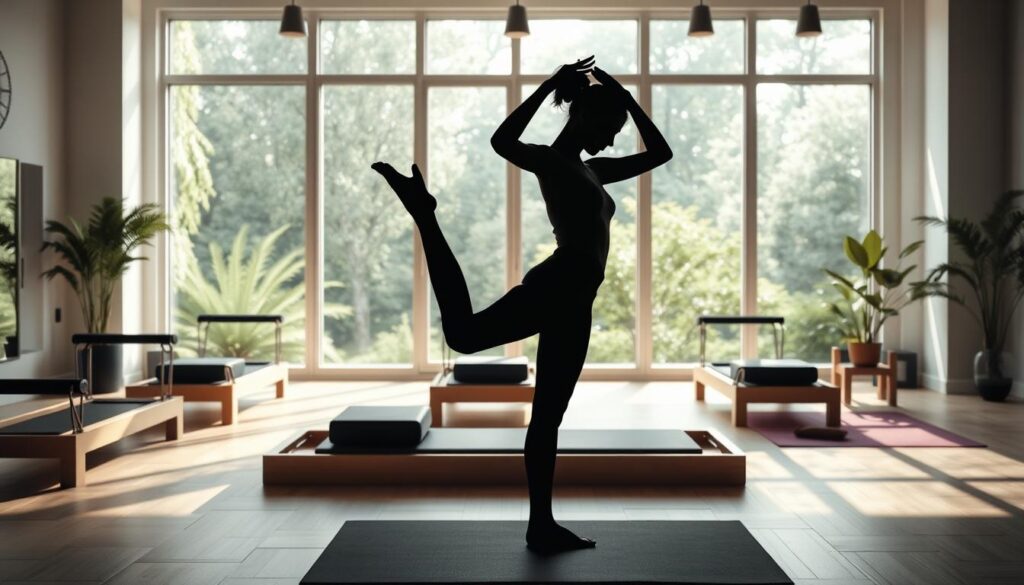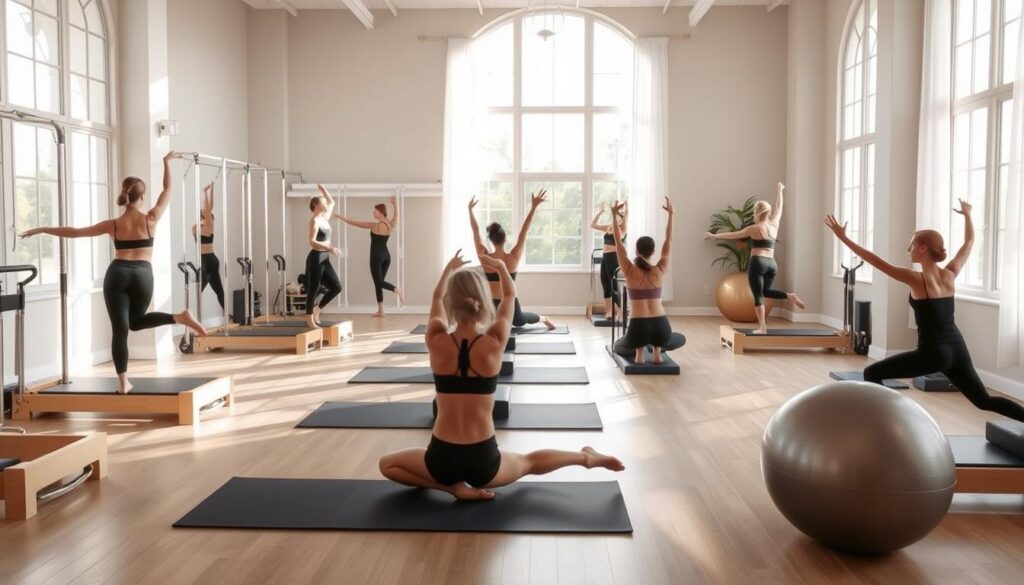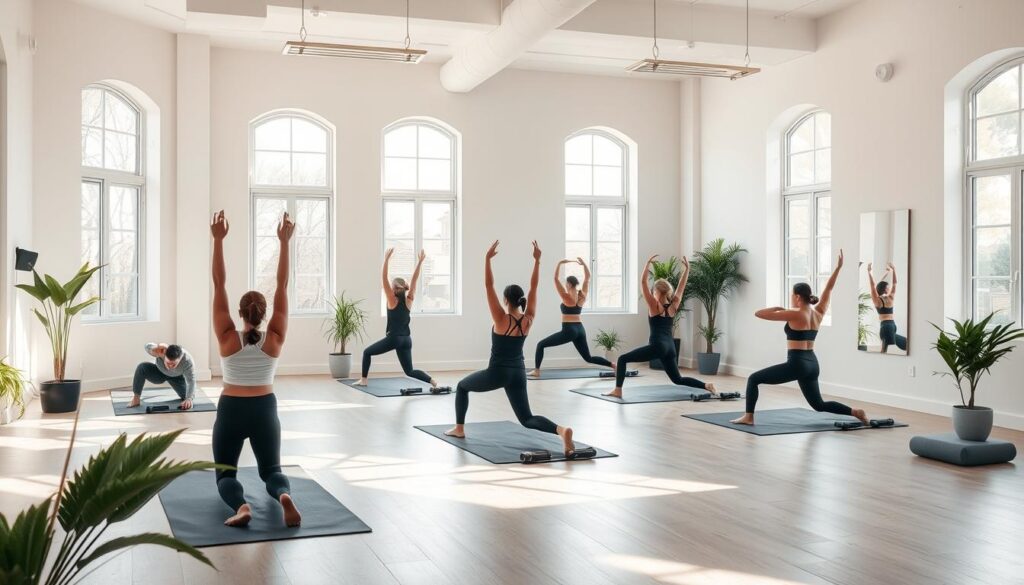If you want to lose weight and get fit, Pilates might be for you. It’s a low-impact workout that strengthens your core. It also boosts flexibility and balance.
Pilates is great for losing weight when you eat right and exercise too. It’s not hard on your joints like some workouts are.
It works your abs, back, and hips. This helps you build lean muscle. More muscle means you burn more calories, even when you’re not moving.
Key Takeaways
- Pilates is a low-impact, full-body workout that can be an effective tool for weight loss
- Pilates helps build lean muscle mass, which increases your metabolic rate and calorie burn
- Pilates focuses on strengthening the core, leading to a toned and sculpted midsection
- Pilates is a convenient exercise option that can be done at home with minimal equipment
- Consistent Pilates practice, combined with a healthy diet, can lead to significant weight loss and body composition improvements
Understanding Pilates and Its Weight Loss Benefits
Pilates was created by Joseph Pilates in the 1930s. It’s a special exercise system that focuses on pilates exercises, posture, balance, and flexibility. It also emphasizes mind-body control.
Unlike regular workouts, Pilates builds strength and muscle. It does this through body recomposition. This helps increase lean muscle toning and raises your basal metabolic rate (BMR).
The Science Behind Pilates-Based Weight Loss
Building lean muscle mass makes you burn calories more efficiently. Even when you’re resting, you burn more calories. Pilates improves core strength, flexibility, and muscle tone.
This makes it a great choice for lasting weight loss.
How Pilates Transforms Your Body
Pilates also promotes mindful movement. This connects your mind and body for better workouts. It makes your workouts more engaging and fulfilling.
Building Lean Muscle Through Pilates
Pilates is a low-impact yet effective way to build lean muscle. It uses targeted exercises and controlled movements. This helps sculpt and tone your body, improving your muscle toning goals.
“Pilates has transformed my body in ways I never thought possible. I’ve gained so much strength and flexibility, and the mindful movement has really helped me stay focused and engaged throughout my workouts.”
Pilates Is Good For Weight Loss: Scientific Evidence
If you want to lose weight, Pilates is a great choice. Many studies show it helps with weight loss. A 2021 study found Pilates lowers body weight and fat in people who are overweight or obese.
The more Pilates you do, the more weight you lose. Another study found 60 minutes of Pilates, 5 times a week for 4 weeks, is best for changing body shape. Pilates is easy on the joints, making it safe for those who want to lose weight and get fit.
| Study | Findings |
|---|---|
| 2021 Study | Pilates effectively reduced body weight and body fat percentage in participants with overweight or obesity, with more pronounced effects in those with obesity. |
| 4-Week Study | 60 minutes of Pilates practice 5 times per week for 4 weeks was optimal for promoting changes in body composition. |
Pilates is not just for losing weight. It also boosts fitness, flexibility, and strength. Adding Pilates to your routine can lead to lasting and effective weight loss.
Calorie Burning Potential in Pilates Sessions
Pilates is great for losing weight because it burns calories. How many calories you burn depends on the type of Pilates, your weight, and how hard you work.
Mat Pilates vs. Reformer Pilates Calorie Burn
A 60-minute mat Pilates session can burn 250-450 calories if you weigh about 150 pounds. Reformer Pilates, with its special equipment, burns a bit more, about 250-450 calories too.
Factors Affecting Calorie Burn During Practice
- Intensity: Harder Pilates workouts burn more calories.
- Duration: Longer sessions burn more calories.
- Body Weight: Heavier people burn more calories doing the same exercises.
- Muscle Engagement: Exercises that work many muscles at once burn more calories.
- Metabolism: Doing Pilates regularly can make your metabolism faster, burning calories even when you’re not working out.
Pilates might not burn as many calories as intense cardio. But it’s a gentle way to lose weight. It also improves flexibility, strengthens your core, and helps your body shape.
| Pilates Workout Type | Calorie Burn (150 lb person) |
|---|---|
| Mat Pilates (60 minutes) | 250-450 calories |
| Reformer Pilates (60 minutes) | 250-450 calories |
Sticking with Pilates is important to burn more calories and reach your weight loss goals. Adding a healthy diet and other exercises can make you even fitter and help with weight control.
Core Strengthening and Body Composition Changes
Pilates is great for making your core stronger. This can make your body look better, even if you don’t lose a lot of weight. You might notice your posture and muscles getting better.
Working on your core is key in Pilates. A stronger core helps your body work better, prevents injuries, and helps you heal faster. You’ll see your muscles getting tighter and your body looking more toned.
A study in March 2021 found Pilates helps with weight loss. People who were overweight lost weight, got slimmer, and had less body fat after eight weeks. They did Pilates for 90 minutes, three times a week.
Another study in November 2017 showed Pilates is good for women too. Women who did Pilates for 90 minutes, three times a week, lost body fat, waist size, and weight after eight weeks.
Pilates might not change your body shape directly. But it makes your core stronger and your muscles tighter. This can make you look more sculpted. By doing Pilates right, you can build lean muscle and get a healthier, more toned body.
| Metric | Pilates Effect |
|---|---|
| Body Weight | Significant reduction |
| BMI | Significant reduction |
| Body Fat Percentage | Significant reduction |
| Waist Circumference | No significant effect |
| Lean Body Mass | No significant effect |
Adding Pilates to your workout routine is a smart move. It’s great for core strengthening, muscle toning, and body sculpting. By focusing on the right form, Pilates can make your core stronger. This leads to a more toned and defined body.
Combining Pilates with Other Weight Loss Strategies
To get the most out of your weight loss, mix Pilates with a healthy diet and other exercises. This mix helps you stay fit and manage your weight better.
Nutrition Guidelines for Maximum Results
Eat foods rich in lean protein, whole grains, fruits, and veggies for weight loss. A diet full of protein keeps you full and gives you the nutrients you need for Pilates and health.
Complementary Exercises for Enhanced Weight Loss
Adding other exercises to Pilates can make your workouts better. Try walking, running, or cycling for more calorie burn and heart health. Strength training also builds muscle, helping you burn fat better.
Creating a Balanced Fitness Routine
For lasting weight loss, balance is key. Do Pilates 2-3 times a week, with cardio and strength training in between. This mix keeps you on track to your fitness goals and keeps you healthy.
“Consistency is the key to success in any fitness journey. Stick to your Pilates practice and complement it with a healthy diet and other forms of exercise for the best results.”
The Role of Consistency in Pilates Practice
To lose weight and stay healthy, you need to do pilates exercises often. Start with 2-3 times a week for beginners. This builds strength and keeps you flexible.
Doing pilates practice regularly also connects your mind and body. It makes you more aware of your body. This leads to better workouts.
As you get stronger, you can do more Pilates. A 2021 study showed Pilates helps you lose weight and body fat. It’s especially good for those who are overweight because it’s easy on the joints.
A study from 2020 found the best results come from doing Pilates 60 minutes, 5 times a week for 4 weeks. This makes your body stronger and more flexible. It helps you manage your weight better.
| Key Pilates Practice Recommendations | Optimal Frequency | Duration |
|---|---|---|
| For Beginners | 2-3 times per week | – |
| For Achieving Body Composition Changes | 5 times per week | 60 minutes per session |
Being consistent is key to Pilates success. Regular Pilates improves your body and mind. It reduces stress and anxiety. Stay with it, and you’ll reach your weight loss and fitness goals.

“The key to a successful Pilates practice is consistency. Commit to regular sessions, and you’ll be amazed by the transformative effects on your body and mind.”
Building a Sustainable Pilates Routine for Weight Management
If you want to lose weight with pilates exercises, make a plan. Start with 2-3 pilates sessions a week. Then, add more as you get stronger.
Frequency Recommendations for Optimal Results
For the best weight loss with pilates, do 3-4 sessions a week. Each should last 20-30 minutes. This helps your body get stronger and burn calories.
Progressive Training Principles
- Start with easy pilates exercises and get harder as you get better.
- Try different pilates styles, like mat and reformer, to work different muscles.
- Pay attention to how you feel and change your workouts if needed.
Being consistent and getting better slowly is important for weight management with pilates. Follow these tips to make a pilates routine that helps you lose weight and stay fit.
Common Mistakes to Avoid in Your Pilates Journey
Starting a Pilates journey can change your life. But, watch out for common mistakes that can stop your progress. Stay away from these errors to get the most out of Pilates and stay safe.
- Neglecting Proper Form: Keeping the right form is key in Pilates. Don’t rush through moves. Slow, controlled movements help you do it right.
- Forgetting Breath Coordination: Breathing right is crucial in Pilates. Match your breath with each move. This helps your core and connects your mind and body.
- Comparing Yourself to Others: Pilates is about your own journey. Don’t compare yourself to others. Focus on your own pace and progress.
- Relying on Pilates Alone for Weight Loss: Pilates is great for core strengthening and mindful movement. But, it’s not enough for weight loss. Eat well and exercise more to see results.
By avoiding these mistakes, you’ll have a great Pilates experience. You’ll unlock the full power of Pilates to change your body and mind.
“The mind, when housed within a healthful body, possesses a glorious sense of power.”
– Joseph Pilates

Tracking Progress and Measuring Success
Your Pilates journey is about more than just the number on the scale. Focus on tracking your progress through improvements in flexibility, strength, and overall body composition. Keep a detailed journal of your Pilates practice, noting advancements in specific exercises and how you feel after each session. Take regular progress photos and measurements to visualize changes in muscle tone and body shape.
Remember that building lean muscle through Pilates may result in minimal weight loss. But it can lead to significant improvements in your body composition and overall fitness. The Eros Smart Body Composition Scale can provide valuable insights into your weight, BMI, body fat, lean mass, and fat mass. This gives you a more comprehensive understanding of your progress.
Avoid the temptation to obsess over the scale, as daily weight fluctuations can be demotivating. Instead, pay attention to how your clothes fit, how your body feels, and the increased ease with which you can perform Pilates exercises. By focusing on these tangible, holistic measures of success, you’ll be able to celebrate your progress in weight loss workouts, body sculpting, and muscle toning.


A Life-Changing Experience with This Weight Loss Supplement (Nagano Tonic)
I’ve always struggled with finding a weight loss solution that actually works for me. Like many, I’ve tried numerous diets, exercise routines, and supplements over the years—some worked for a short time, but nothing ever gave me long-term results. That was until I decided to try the weight loss supplement I found : Link to the Supplement.
From the moment I started using it, I noticed a difference. Not only did I feel more energized, but my cravings also became more manageable. The best part? I started seeing results much quicker than I anticipated! Over the course of just a few weeks, I noticed a significant reduction in belly fat and overall weight loss that I hadn’t been able to achieve before.
What makes this supplement stand out from all the others I’ve tried is how it supports me in my daily routine without any jitters or energy crashes. I’m able to stay focused and motivated, which has made it easier to stay on track with my diet and exercise plan.
This product truly exceeded my expectations, and I feel more confident and healthier than ever before. If you’re struggling with your weight loss journey like I was, I highly recommend giving this supplement a try. It’s been a game-changer for me, and I’m sure it can work wonders for you too!
Contant Them on email .. tonicnagano50@gmail.com
I’ve tried so many weight loss products over the years, but nothing worked like this supplement! Since I started using it, I’ve noticed a big difference in my energy levels and appetite control. In just a few weeks, I’ve lost weight and feel so much better. It’s been easy to stick with, and the results speak for themselves. Highly recommend this to anyone looking to make a real change!
wasn’t sure what to expect, but this weight loss supplement has really impressed me! After just a few weeks of use, I’ve already dropped a few pounds and feel more motivated to stay active. It’s helped curb my cravings and boosted my energy throughout the day. I’m excited to keep going and see even better results. Definitely worth trying!
Reach them on tonicnagano50@gmail.com
I was skeptical at first, but this supplement has truly made a difference in my weight loss journey. I’ve lost weight without feeling deprived or sluggish. My cravings are under control, and I feel more confident in my body. It’s easy to incorporate into my daily routine, and the results speak for themselves. I’m so glad I gave it a try!
Thanks David, i do use the link to make my purchase. you can get too here http://surl.li/iasppy
I’ve tried so many weight loss products, but this one has been by far the most effective. In just a few weeks, I’ve noticed a visible difference in my body and energy levels. It’s helped me stay on track without the constant hunger pangs and cravings. I’m really happy with my progress and can’t wait to see where I’ll be in another month!
This Nagano Tonic has been amazing! In just a few weeks, I’ve lost weight, feel more energized, and my cravings are under control. Highly recommend it!
Thats the link to purchase http://surl.li/iasppy